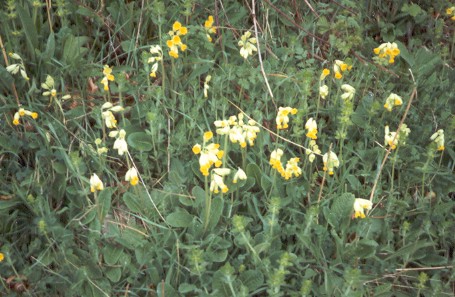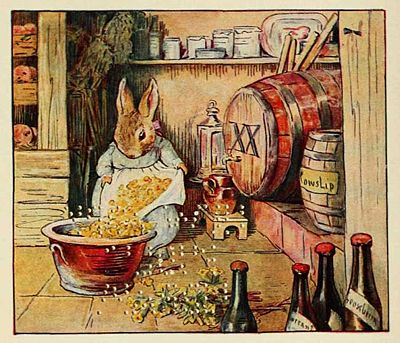
Primula veris (L)
Synonyms and Common names: Primula officinalis (L), paigle, peagle, peggle, primula, keyflower, key of heaven, palsywort, fairy cups, petty mulleins, crewel, buckles, plumrocks, mayflower, password, artetyke, drelip, Our Lady�s keys, Arthritica, Herb Peter
French = Primerolle or clef de Saint Pierre, German = Petersblume, Spanish = Vellorita, Italian = Primavera
Order: Primulaceae

Description: Primula veris is a well-known wildflower, native to meadows and pastures throughout England, Europe and temperate Asia. A hairy perennial, it has loose rosettes of oblanceolate to obovate, wrinkled leaves, 50-250mm long. The lobes of the calyx are acute at the apex. The bright yellow flowers are funnel-shaped, 8-28mm across, with orange spots at the base of each lobe, all drooping to one side in a cluster of ten to thirty on a long naked stalk. The ripe capsule is shorter than the calyx, and contains dry seeds. The plant favours open woodland, scrub and grassland on lime-rich soils.
Parts used: flowers; occasionally the root
Collection: The flowers should be collected, without the green calyx, between March and May. The roots should be unearthed before flowering or in the autumn. Primula veris is becoming increasingly rare, so should not be collected in the wild.
Constituents: up to 10% saponin glycosides (particularly in the root, and including primulaveroside and primoveroside which contain salicylates), flavonoids (mainly in the flowers, including quercetin, luteolin, kaempferol and apigenin and their glycosides), phenolic glycosides, tannins, and about 0.1% volatile oil
Actions: sedative, spasmolytic, expectorant, hypnotic, mild diuretic, mild aperient
Indications: insomnia, nervous excitability, hysteria. Specifically indicated in anxiety states associated with restlessness and irritability.
Therapeutics and Pharmacology: Primula is a relaxing, sedative remedy, indicated in states of tension and nervous excitability. The flowers, which contain most of the essential oil known as �primula camphor�, are indicated in insomnia and nervous tension. The main active constituents are the flavonoids which exhibit anti-inflammatory and antispasmodic activity. They inhibit the release of histamine and act as free radical scavengers. The flowers also have a reputation for treating measles, and an ointment made from them brings relief to sunburn.
The high saponin content in the root probably accounts for its reputation in the treatment of pertussis and bronchitis, while the salicylates explain its use on the Continent in the treatment of arthritic conditions; the root was known as Radix arthritica in the past. The root is also thought to be mildly diuretic and to slow blood clotting.
 Combinations: Primula may be combined with Humulus
and Passiflora in
insomnia, with Valeriana in hysteria and with Cypripedium and
Scutellaria in
anxiety states.
Combinations: Primula may be combined with Humulus
and Passiflora in
insomnia, with Valeriana in hysteria and with Cypripedium and
Scutellaria in
anxiety states.
Caution: The stamens may cause contact dermatitis.
Preparation and Dosage: (thrice daily)
Regulatory Status: GSL Schedule 1
Dried flowers: 1-2g as infusion
Liquid Extract: 1:1 in 25% alcohol, 1-2ml
Additional Comments: According to legend, cowslips first appeared from the ground where St. Peter dropped his keys, accounting for some of the common names of this plant. There used to be a widespread belief that cowslips would produce red flowers if they were planted upside down.
Cowslip wine (from Cecily Parsley's Nursery Rhymes by Beatrix Potter)
Bibliography
Bartram, T. 1995 Encyclopedia of Herbal Medicine, 1st edn.,Grace Publishers, Bournemouth.
BHMA 1983 British Herbal Pharmacopoeia, BHMA, Bournemouth.
Chevallier, A. 1996 The Encyclopedia of Medicinal Plants, Dorling Kindersley, London.
Grieve, M. 1931 A Modern Herbal, (ed. C.F. Leyel 1985), London.
Hoffmann, D. 1990 The New Holistic Herbal, Second Edition, Element, Shaftesbury.
Mabey, R. (ed.) 1991 The Complete New Herbal, Penguin, London.
Newall, C.A., Anderson, L.A., & Phillipson, J.D. 1996 Herbal Medicines: A Guide for Health-care Professionals, The Pharmaceutical Press, London.
Ody, P. 1993 The Herb Society's Complete Medicinal Herbal, Dorling Kindersley, London.
Polunin, M. and Robbins, C. 1992 The Natural Pharmacy, Dorling Kindersley, London.
Press, B. & Gibbons, B. 1993 Wild Flowers of Britain and Europe: Photographic Field Guide, New Holland Publishers, London.
Vickery, R. 1995 A Dictionary of Plant Lore, Oxford University Press.
Weiss, R.F. 1991 Herbal Medicine, Beaconsfield Arcanum, Beaconsfield.
Wren, R.C. 1988 Potter's New Cyclopaedia of Botanical Drugs and Preparations, C.W.Daniel, Saffron Walden.










